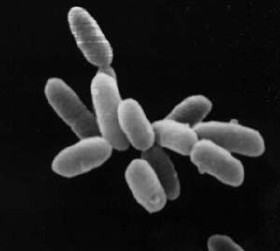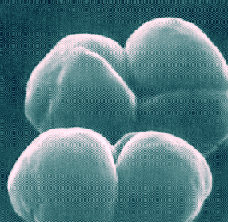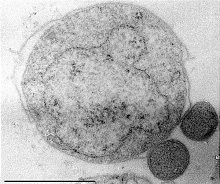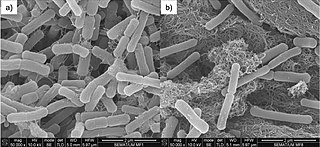Related Research Articles

Bacilli is a taxonomic class of bacteria that includes two orders, Bacillales and Lactobacillales, which contain several well-known pathogens such as Bacillus anthracis. Bacilli are almost exclusively gram-positive bacteria.

Euryarchaeota is a phylum of archaea. Euryarchaeota are highly diverse and include methanogens, which produce methane and are often found in intestines, halobacteria, which survive extreme concentrations of salt, and some extremely thermophilic aerobes and anaerobes, which generally live at temperatures between 41 and 122 °C. They are separated from the other archaeans based mainly on rRNA sequences and their unique DNA polymerase.
Chrysiogenaceae is a family of bacteria.
The Thermoprotei is a class of the Thermoproteota.
Rhodobacterales are an order of the Alphaproteobacteria.
In taxonomy, the Methanopyri are a class of the Euryarchaeota.

In taxonomy, the Thermoplasmata are a class of the Euryarchaeota.

In taxonomy, the Thermoplasmatales are an order of the Thermoplasmata. All are acidophiles, growing optimally at pH below 2. Picrophilus is currently the most acidophilic of all known organisms, being capable of growing at a pH of -0.06. Many of these organisms do not contain a cell wall, although this is not true in the case of Picrophilus. Most members of the Thermotoplasmata are thermophilic.

In taxonomy, the Thermococci are a class of microbes within the Euryarchaeota.

In the taxonomy of microorganisms, the Methanomicrobia are a class of the Euryarchaeota.

The Desulfurococcales is an order of the Thermoprotei, part of the kingdom Archaea. The order encompasses some genera which are all thermophilic, autotrophs which utilise chemical energy, typically by reducing sulfur compounds using hydrogen. Desulfurococcales cells are either regular or irregular coccus in shape, with forms of either discs or dishes. These cells can be single, in pairs, in short chains, or in aciniform formation.
The Pyrodictiaceae are a family of disc-shaped anaerobic microorganisms belonging to the order Desulfurococcales, in the domain Archaea. Members of this family are distinguished from the other family (Desulfurococcaceae) in the order Desulfurococcales by having an optimal growth temperature above 100 °C, rather than below 100 °C.
Sphingobacteriia is a taxonomic class composed of a single order of environmental bacteria that are capable of producing sphingolipids. The earlier name Sphingibacteria was changed in 2011.
In taxonomy, Amaricoccus is a genus of the Rhodobacteraceae.
In taxonomy, Rhodothalassium is a genus of the Rhodobacteraceae. Up to now there is only one species of this genus known.
In taxonomy, "Marinosulfonomonas" is a genus.
In taxonomy, Octadecabacter is a genus of the Rhodobacteraceae.
Roseovarius is a genus of bacteria in the family Roseobacteraceae.
In taxonomy, Sagittula is a genus of the Rhodobacteraceae.

Methanobacterium is a genus of the Methanobacteriaceae family of Archaea. Despite the name, this genus belongs not to the bacterial domain but the archaeal domain. Methanobacterium are nonmotile and live without oxygen as anaerobic bacterium. They do not create endospores when nutrients are limited. Some members of this genus can use formate to reduce methane; others live exclusively through the reduction of carbon dioxide with hydrogen. They are ubiquitous in some hot, low-oxygen environments, such as anaerobic digestors, their waste water, and hot springs.
References
- ↑ See the NCBI webpage on Tetracoccus. Data extracted from the "NCBI taxonomy resources". National Center for Biotechnology Information . Retrieved 2007-03-19.